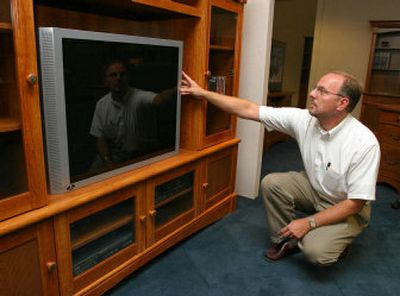Furniture changes for TVs

As prices for high-tech plasma TVs shrink, retailers and furniture makers are rolling out new entertainment units designed to fit the sleeker screens with hopes that new designs will boost sales.
“Furniture development was behind the curve,” said Craig Stout, vice president of design and product development at Ethan Allen Interiors Inc. “The selection has caught up with the technology.”
Ethan Allen, based in Danbury, Conn., came out this year with three styles of entertainment centers. The company this fall will begin selling a cabinet with a lift that allows an ultra-thin plasma TV to rise and lower with the touch of a remote-control. It will cost about $3,000, while the furniture retailer’s standard entertainment centers start at $799.
“It’s going to appeal to the consumer who doesn’t want their living space to look like a home theater,” Stout said.
Susan Dountas, vice president of merchandising at Archbold, Ohio-based Sauder Woodworking Co., a maker of ready-to-assemble furniture, said the drop in prices for high-definition televisions has helped with a steady increase in home entertainment unit sales.
“It’s getting more affordable for our customer,” she said. “We’re not a high-end furniture supplier.”
The furniture industry doesn’t specifically track sales of home entertainment centers, and individual companies wouldn’t release their sales figures, but sales of plasma television sets jumped by nearly 150 percent last year. They’re expected to climb by nearly 70 percent this year, bringing the total sales for this year to 1.4 million units, according to the Consumer Electronics Association, a manufacturers trade group.
Prices for some plasma and liquid-crystal display TVs have fallen below $2,000. They sold for five times that much just a few years ago.
Roger Abady, a salesman at Audio Craft, a Cleveland electronics store, said some TV shoppers bring a tape measure with them when looking for a bigger screen, hoping they won’t need to buy new furniture.
“They have a square cabinet and they want to fit a rectangular screen in there,” he said. “It’s devilishly hard.”
The styles vary for new entertainment centers, from traditional armoires with a cherry finish and wraparound doors to modern stands with glass shelves and a metallic finish. Credenzas with plenty of storage space also are popular.
Most of the stands are designed to fit the new TVs that are rectangular and not as wide as older models.
Furniture makers are finding that most folks buying 50-inch plasma and liquid-crystal display TVs still want some way to conceal them when they’re not in use.
Some sellers say it’s a gender-driven preference — men want the televisions out in the open and women would rather hide them behind doors.
“Most people want the warmth of home furnishings,” said Mark Fink, president of Wood Technology Inc., which supplies hardware to furniture makers. “The majority of furniture buyers are still traditional.”
That doesn’t mean there won’t be any radical changes.
Remote-control lifts someday also could make plasma TV screens pop out of kitchen counters or the front end of a bed, said Fink, whose company based in Pittsboro, N.C., is making the lifts.